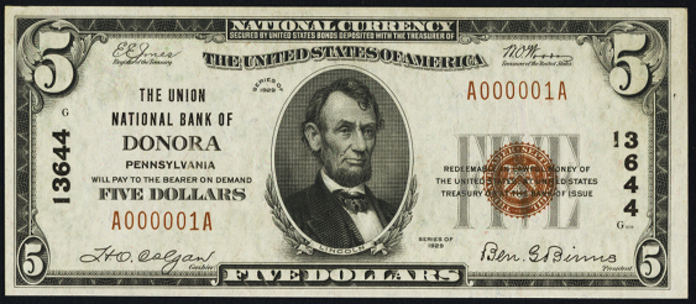Five Dollar Notes › Nationals › 1929 Five Dollar National Bank Notes › Texas Charters › 1929 $5 Schulenburg Texas First National Bank
Get Value Now
| Item | Info |
|---|---|
| Series | 1929 |
| Charter | #8034 First National Bank of Schulenburg, Texas |
| Year Chartered | 1906, 462 Banks Chartered |
| City Info | Schulenburg is a city in Fayette County, Texas, United States. The population was 2,852 at the 2010 census. Known for its German culture, Schulenburg is home of the Texas Polka Music Museum. In 1831, the Mexican government granted 4,428 acres of land to Kesiah Crier. Crier's family and the James Lyons family were the first white settlers in the area. The town of Schulenburg developed from two nearby communities: Lyons, founded in 1842, and High Hill, settled in 1842 and later named in 1858. In 1873, the Galveston, Harris and San Antonio Railroad bought land in the area, then built a depot on the portion formerly owned by Louis Schulenburg, naming it after him. The first train arrived on New Year's Eve of 1873, and the town was formally incorporated on May 24, 1875. Source: Wikipedia |
| Similar Cities | City name is unique, no others like it. |
| Seal Varieties | Small Brown |
| See Also | If your note doesn't match try: 1. 1929 $5 Federal Reserve Bank Note 2. 1928 $5 Federal Reserve Note 3. 1928A $5 Federal Reserve Note 4. 1928B $5 Federal Reserve Note 5. 1928C $5 Federal Reserve Note 6. 1928D $5 Federal Reserve Note 7. 1934 $5 Federal Reserve Note |
| Other Info | 1. Value depends on notes known for charter, condition and market demand. |
| Neat Fact | Issued in sheets of 6 Note (Friedbergs, 20th Ed. P191) |
No Obligations Offers and Appraisals
Please submit a good photo or scan. It will be identified and evaluated. Understand there may be subtle differences between the image you see above and your note. Signatures, design, markings and note condition will determine the offer price. Notes in Uncirculated or better condition receive the best offers.
Appraisals can be estimated for wholesale and retail prices. Wholesale is what dealers typically pay. Retail is what a collector might pay. Retail is slightly higher in most cases.
Please visit this page for USA Paper Money Reference. Do not treat this page as a reference guide, it is for appraisal and acquisition purposes only.
